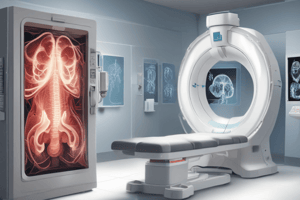Podcast
Questions and Answers
What did Roentgen discover on 8 November 1895?
What did Roentgen discover on 8 November 1895?
Which diagnostic imaging modality was historically discovered by Roentgen?
Which diagnostic imaging modality was historically discovered by Roentgen?
What is the basic principle of X-rays?
What is the basic principle of X-rays?
Which example of electromagnetic radiation has the lowest frequency?
Which example of electromagnetic radiation has the lowest frequency?
Signup and view all the answers
How are images obtained in plain radiography?
How are images obtained in plain radiography?
Signup and view all the answers
Which diagnostic imaging modality was historically discovered by Roentgen?
Which diagnostic imaging modality was historically discovered by Roentgen?
Signup and view all the answers
What is the basic principle of X-rays?
What is the basic principle of X-rays?
Signup and view all the answers
Which example of electromagnetic radiation has the shortest wavelength?
Which example of electromagnetic radiation has the shortest wavelength?
Signup and view all the answers
How are images obtained in plain radiography?
How are images obtained in plain radiography?
Signup and view all the answers
Which of the imaging modalities involves a PET CT?
Which of the imaging modalities involves a PET CT?
Signup and view all the answers
Study Notes
Discovery of X-rays
- Wilhelm Conrad Roentgen discovered X-rays on 8 November 1895.
- He discovered X-rays as a diagnostic imaging modality.
Basic Principle of X-rays
- The basic principle of X-rays is that they are a form of electromagnetic radiation.
Electromagnetic Radiation
- X-rays are an example of electromagnetic radiation with a high frequency.
- They are an example of electromagnetic radiation with a short wavelength.
Plain Radiography
- Images are obtained in plain radiography by using X-rays.
- X-rays are used to create images of the body in plain radiography.
Imaging Modalities
- PET CT is a combination of two imaging modalities: Positron Emission Tomography (PET) and Computed Tomography (CT).
Studying That Suits You
Use AI to generate personalized quizzes and flashcards to suit your learning preferences.
Description
This course provides an overview of different diagnostic imaging modalities, including their physical background, clinical applications, advantages, and disadvantages. It also covers interpretations and applications of imaging in various body systems, such as chest x-ray, neuroimaging, GIT imaging, and musculoskeletal imaging.




